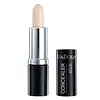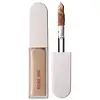What's inside
What's inside
 Key Ingredients
Key Ingredients

 Benefits
Benefits

 Concerns
Concerns

No concerns
 Ingredients Side-by-side
Ingredients Side-by-side

Caprylic/Capric Triglyceride
MaskingOctyldodecanol
EmollientBis-Diglyceryl Polyacyladipate-2
EmollientSynthetic Wax
AbrasiveCandelilla Cera
EmollientKaolin
AbrasiveHydrogenated Dimer Dilinoleyl/Dimethylcarbonate Copolymer
Emulsion StabilisingDicalcium Phosphate
AbrasiveTribehenin
EmollientDisteardimonium Hectorite
StabilisingBoron Nitride
AbsorbentSynthetic Fluorphlogopite
Mica
Cosmetic ColorantPolyhydroxystearic Acid
EmulsifyingPhysalis Pubescens Fruit Juice
Skin ConditioningPentaerythrityl Tetra-Di-T-Butyl Hydroxyhydrocinnamate
AntioxidantTin Oxide
AbrasiveTocopherol
AntioxidantCI 77891
Cosmetic ColorantCI 77492
Cosmetic ColorantCI 77491
Cosmetic ColorantCI 77499
Cosmetic ColorantCI 42090
Cosmetic ColorantCaprylic/Capric Triglyceride, Octyldodecanol, Bis-Diglyceryl Polyacyladipate-2, Synthetic Wax, Candelilla Cera, Kaolin, Hydrogenated Dimer Dilinoleyl/Dimethylcarbonate Copolymer, Dicalcium Phosphate, Tribehenin, Disteardimonium Hectorite, Boron Nitride, Synthetic Fluorphlogopite, Mica, Polyhydroxystearic Acid, Physalis Pubescens Fruit Juice, Pentaerythrityl Tetra-Di-T-Butyl Hydroxyhydrocinnamate, Tin Oxide, Tocopherol, CI 77891, CI 77492, CI 77491, CI 77499, CI 42090
Water
Skin ConditioningC9-12 Alkane
SolventGlycerin
HumectantPropanediol
SolventTribehenin
EmollientPentylene Glycol
Skin ConditioningPolyglyceryl-3 Polyricinoleate
EmulsifyingSorbitan Isostearate
EmulsifyingDisteardimonium Hectorite
StabilisingCaprylic/Capric Triglyceride
MaskingCoco-Caprylate/Caprate
EmollientSqualane
EmollientRanunculus Ficaria Extract
Skin ConditioningAcmella Oleracea Extract
Skin ProtectingSodium Hyaluronate
HumectantLysine
Skin ConditioningTocopherol
AntioxidantMagnesium Chloride
Aluminum Hydroxide
EmollientGlyceryl Caprylate/Caprate
EmollientSodium Lauroyl Glutamate
CI 77891
Cosmetic ColorantIron Oxides
Water, C9-12 Alkane, Glycerin, Propanediol, Tribehenin, Pentylene Glycol, Polyglyceryl-3 Polyricinoleate, Sorbitan Isostearate, Disteardimonium Hectorite, Caprylic/Capric Triglyceride, Coco-Caprylate/Caprate, Squalane, Ranunculus Ficaria Extract, Acmella Oleracea Extract, Sodium Hyaluronate, Lysine, Tocopherol, Magnesium Chloride, Aluminum Hydroxide, Glyceryl Caprylate/Caprate, Sodium Lauroyl Glutamate, CI 77891, Iron Oxides
 Reviews
Reviews

Ingredients Explained
These ingredients are found in both products.
Ingredients higher up in an ingredient list are typically present in a larger amount.
This ingredient is an emollient, solvent, and texture enhancer. It is considered a skin-softener by helping the skin prevent moisture loss.
It helps thicken a product's formula and makes it easier to spread by dissolving clumping compounds.
Caprylic Triglyceride is made by combining glycerin with coconut oil, forming a clear liquid.
While there is an assumption Caprylic Triglyceride can clog pores due to it being derived from coconut oil, there is no research supporting this.
Learn more about Caprylic/Capric TriglycerideCi 77891 is a white pigment from Titanium dioxide. It is naturally found in minerals such as rutile and ilmenite.
It's main function is to add a white color to cosmetics. It can also be mixed with other colors to create different shades.
Ci 77891 is commonly found in sunscreens due to its ability to block UV rays.
Learn more about CI 77891Disteardimonium Hectorite comes from the clay mineral named hectorite. It is used to add thickness to a product.
It can also help stabilize a product by helping to disperse other ingredients.
Hectorite is a rare, white clay mineral.
Learn more about Disteardimonium HectoriteTocopherol (also known as Vitamin E) is a common antioxidant used to help protect the skin from free-radicals and strengthen the skin barrier. It's also fat soluble - this means our skin is great at absorbing it.
Vitamin E also helps keep your natural skin lipids healthy. Your lipid skin barrier naturally consists of lipids, ceramides, and fatty acids. Vitamin E offers extra protection for your skin’s lipid barrier, keeping your skin healthy and nourished.
Another benefit is a bit of UV protection. Vitamin E helps reduce the damage caused by UVB rays. (It should not replace your sunscreen). Combining it with Vitamin C can decrease sunburned cells and hyperpigmentation after UV exposure.
You might have noticed Vitamin E + C often paired together. This is because it is great at stabilizing Vitamin C. Using the two together helps increase the effectiveness of both ingredients.
There are often claims that Vitamin E can reduce/prevent scarring, but these claims haven't been confirmed by scientific research.
Learn more about TocopherolTribehenin comes from glycerin and behenic acid.
It is used as an emollient, or moisturizer. Emollients form a thin barrier on skin to prevent moisture from escaping.
This ingredient may not be Malassezia folliculitis, or fungal-acne safe.
Learn more about Tribehenin